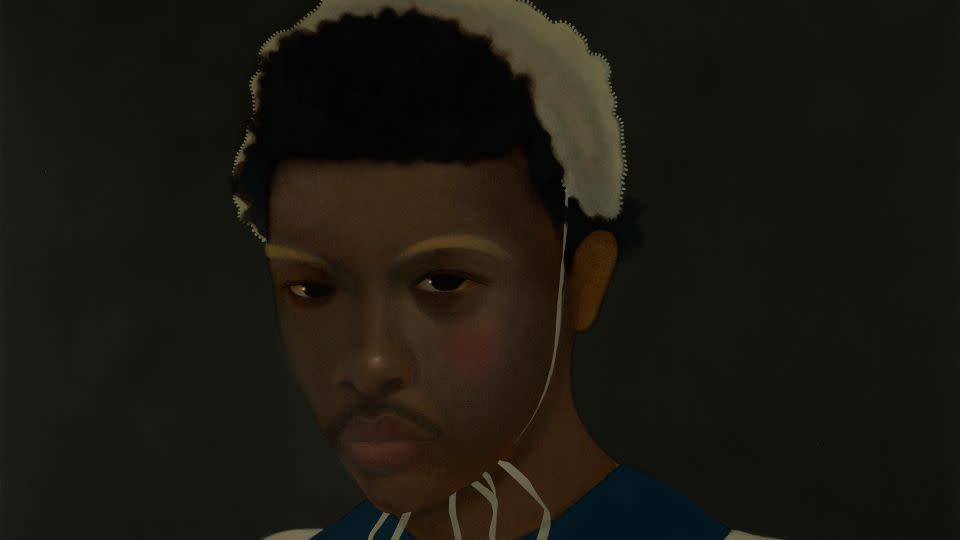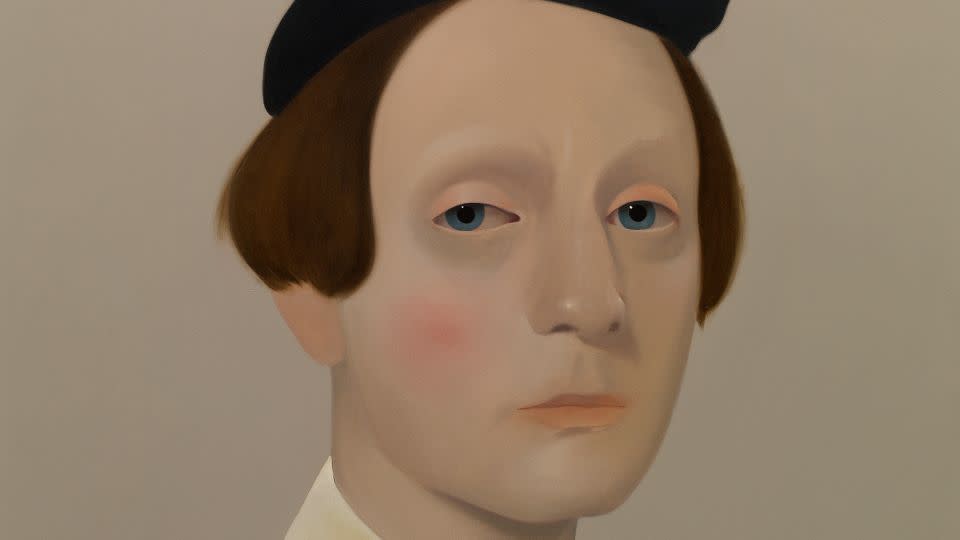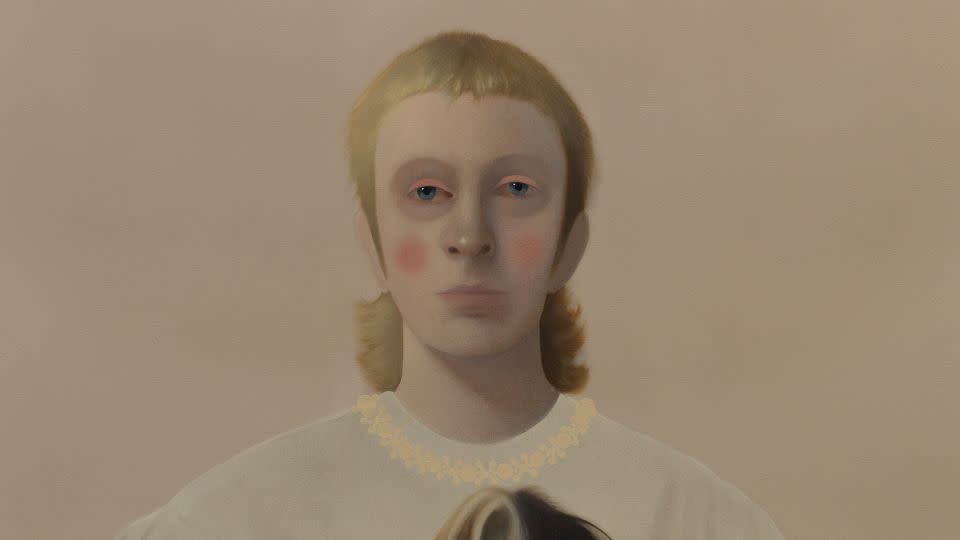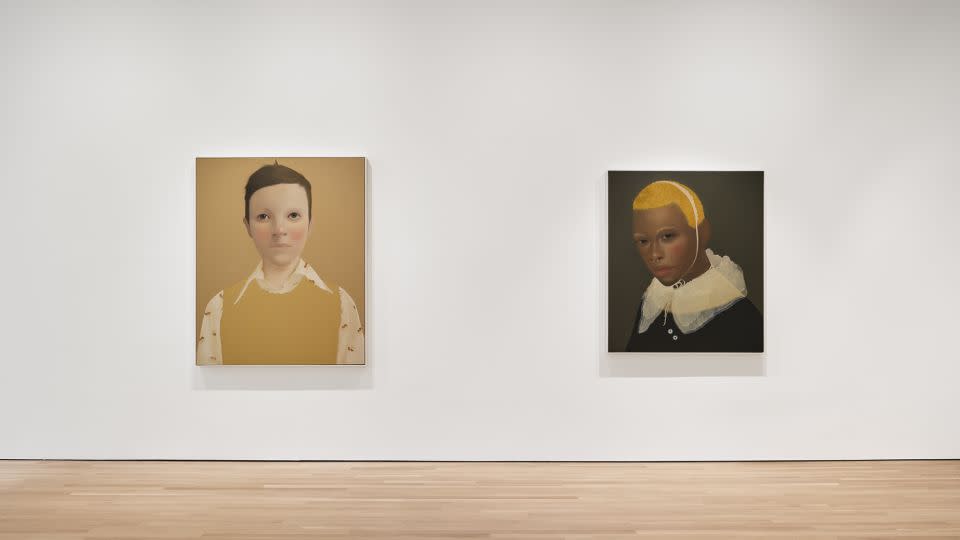The painter reframing ‘dandies’ for the female gaze
- Oops!Something went wrong.Please try again later.
Writing in 1863, the French poet and critic Charles Baudelaire turned his eye to a striking faction of Parisian and English high society, one militantly fanatical for appearances — so much that some were said to polish their boots with Champagne. “Dandyism is a mysterious institution,” he said of the cult of the fastidiously-dressed, 19th-century male, “no less peculiar than the duel.”
Though himself no stranger to decadence — with a predilection for satin, velvet and changing his hair on a whim, Baudelaire squandered an inheritance with his louche taste for clothing and opium — he identified in the dandy’s subversive character a “burning desire to create a personal form of originality.”
Scores of subcultures have embraced and interpreted the archetype in the decades since. Rather than Beau Brummell’s crisply-tied cravat, today the term “dandy” may summon visions of Harry Styles in a string of freshwater pearls or playwright Jeremy O. Harris’ natty Thom Browne suiting. But its preening, self-curated elegance remains, beyond limits of the gender binary or preconceived notions of how one “should” dress.
“There’s not one definitive description,” observed the British artist Sarah Ball in a video call with CNN. “Gender norms are so blurred now, fantastically. It’s a moving scale, wherever we choose to be.”


The concept of the dandy in the twenty-first century — and how it may be defined or disrupted — is the connective thread of Ball’s first New York solo exhibition, “Tilted,” which debuted at Stephen Friedman Gallery in Tribeca earlier this year. Comprising 10 large-scale, tightly composed portraits in Ball’s signature airy stretches of color, the show challenges conventions of gender and celebrates the exuberance of self-expression.
Each of the personalities represented in “Tilted” is dressed in their own idiosyncratic accoutrements, rendered in minute detail: rakish beribboned headgear, delicate lace collars and bonnets, expressive makeup, oversized eyewear and, in one instance, even a cocktail glass, holding a slosh of liquid and the briny green of a Castelvetrano olive. Ball — who works from a studio in the small English town of St Ives, Cornwall, where artists have been drawn to the light and the sea for generations — typically finds her subjects through social media or on the street, attracted by their “degree of complete individuality,” she told CNN.
Exploring the dandy persona has been a natural development for Ball, whose work needles the tension between self-identity and the performance of outward presentation. “It’s part of a much bigger idea: how we are defined by others or how we define ourselves. That can be anything — race, ethnicity, or religion, or sexuality or gender fluidity,” she told CNN. “I’ve always been very interested in how we present a version of ourselves externally; how our personality manifests itself.”
For all the wit in the clothes, there is a stillness and a surreal quality in Ball’s portraits that place her subjects slightly out of time. “That is definitely something I seek when I’m looking for people to paint,” she said. Indelible personal style is also crucial to the allure. Ball doesn’t costume her subjects, though she edits details to balance the composition. “They’re ready-made, in a way,” she explained, “but then the painting really does take over.”

At over eight feet tall, “Declan (In Simone Rocha With Eddie),” depicts an individual in a sumptuous, crystal-embroidered smock dress by the Irish designer, known for her rebellious take on historic ritual, “feminine” codes and gender play. Accompanied by their long-haired guinea pig Eddie, swaddled in a lace-edged handkerchief, Declan’s coiffed shag haircut could read 18th century Flanders — or any contemporary hipster enclave, be it in Brooklyn or Berlin.
An encounter with the writer Andrew Solomon’s 2004 essay Dandyism, published years before Instagram and other social media became the de facto avenue for exhibitionist display, influenced the body of work, according to Ball. “I’ve always looked (at) and used historical archives as a way of connecting with what’s happening in the world at the moment,” Ball said. “It’s a bit tongue in cheek, but the idea of ‘promenade’ in showing oneself peacocking is the same as people use social media for, really.” (Cue Solomon, quoting the French novelist Jules Barbey d’Aurevilly, “To appear to be is to be for Dandies.”)

Two figures in the show, Von and Henry, materialize in multiple guises, demonstrating the transformativeness of persona construction and the depth of what may lie beyond the surface. “I’m aware that Instagram allows us to curate an image, an idea of ourselves, but unless you know that person, you don’t really ever know whether that’s true,” Ball noted. “There’s that intersection where truth meets fiction.”
Her interpretations on the dandy shows how mutable and fluid the persona is, as Ball name-checks a series of female inspirations for the ‘look;’ the outré trouser suits and cropped bobs introduced by designer Gabrielle “Coco” Chanel, screen cipher Marlene Dietrich and Sandy Powell, the flame-haired, bespectacled costume designer known for her collaborations with directors Martin Scorsese and Todd Haynes.
What remains is pure individual verve. “I’ve always been drawn to people that have not followed one path or another…who are extroverts, theatrical, unusual, creative, and wonderful,” Ball said.
For more CNN news and newsletters create an account at CNN.com

